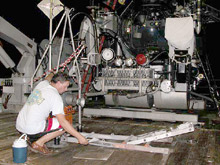
If you lived at the bottom of the ocean, this is how your world would appear. Click image for larger view.
Feeling the Darkness; Seeing the Light
August 11, 2004
News Flash:
Brian Johnson
Environmental Analyst
NOAA
National Ocean Service
How do you walk into a dark room? Do you reach instantly for the light switch? Do you let the door close behind you and embrace the darkness? Or do you find a source of light -- before entering?
Many times it seems our natural path is to follow the light and travel along well-lighted corridors to some predetermined destination. We seek our route along familiar and brightly illuminated paths. This philosophy applies whether we're finding our way through a dark room, or seeking answers to unknown questions.
Now imagine yourself in a room void of any light, without any light switch. How would you find your shelter, locate your next meal, or even encounter your future mate? What if there were no predetermined path? How could you solve your dilemma?
On Operation Deep Scope our philosophy is this: sometimes you need to let go of what is familiar before you can seek the path to your answers. Sometimes you must encounter darkness before you appreciate the light.

As this log is being written, a few members of the science party worked to re-engineer the optical jelly on the Eye-in-the-Sea. The sub divers who deploy this deep-water video station had requested a better way to engage this component only a day earlier. A piece of a ladder, some metal and plastic ties, and little creative energy is all that was required. We will test the alterations tomorrow morning. Click image for larger view.
Every objective of this cruise involves the investigation of how deep-sea organisms -- the ones living in places with little to no light -- survive. The challenges to studying them go beyond simply building the tools that can sustain the extreme temperature and pressure where they live. The reality is that we cannot use light to see them. The "white" light we are so accustomed to using is too strong for their ultra-sensitive eyes. When we flash our bright, curious searchlights into their world, it's like forcing these creatures to stare directly into the sun. Those with functioning eyes are blinded by our curiosity, and the gelatinous "jellies" become invisible in this intensity.
The science team is testing non-invasive observation tools that use red-light sensors, light-tight traps, and sophisticated optical filters. These tools are designed to observe and collect deep-sea specimens with their vision intact, or in ways that increase our understanding of how they use light. This is a fundamentally new way of exploring this dark, dark world. In essence, the team let the door close behind them, and reached out for new answers where there were none.

Tropical Storm Bonnie makes her way across the Gulf of Mexico, with Hurricane Charley a few days behind. The science party intently watches the projected paths, and so far has managed to dodge the brunt of the storms. Click image for larger view.
Ocean exploration is very much like this. There are not always predetermined paths to uncover the answers to countless unknowns about the largest living space on the planet -- the oceans. Just as Tropical Storm Bonnie forced us to change course, and with Hurricane Charley threatening our future destinations, the team is responding with new ideas and alternate dive sites.
Sometimes you need to feel the darkness before you can see the light.























